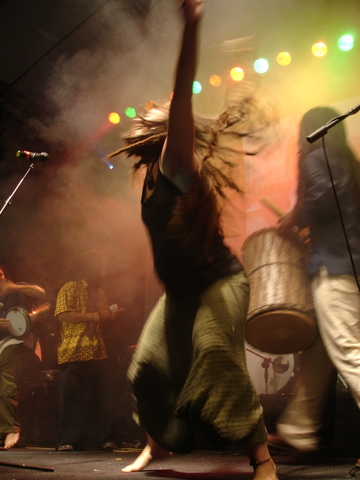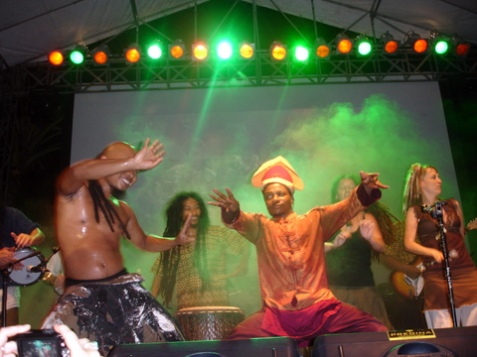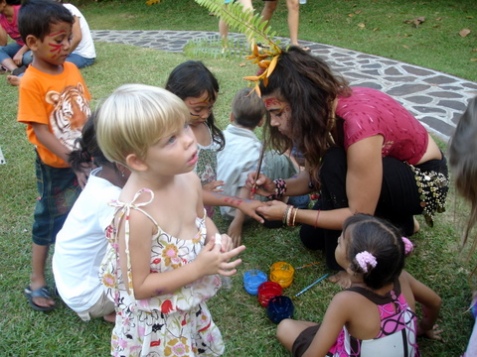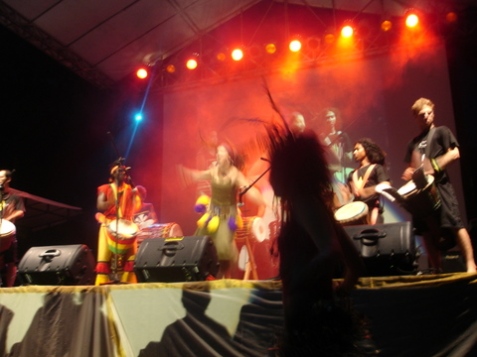
Bali Herbal Walks
I drive up to Ubud early in the morning, dark ominous clouds hang over the hills creating a moody backdrop. I hope the rain will hold off for the next few hours as I have signed up for a herbal walk, and trudging through rice fields in torrential rain isn’t quite what I have in mind. I meet my guide, Westi, a wise and gentle soul with an innate knowledge of all things herbal. He and his wife Lilir have been leading guests on walks through the ravines and rice fields of Ubud for twelve years. Their extensive knowledge of herbalism gained from their families, working in the field, and from years of studying with traditional healers.
The use of natural medicines, known as Usada, is a strong custom in Bali, as traditionally the only medicines that people had access to were those provided by nature. Most Balinese have some knowledge of natural cures and many families keep an apotek hidup (living drugstore), a small garden of herbs with medicinal properties in their yard. The edges of Bali’s fertile rice fields also host a plethora of herbs, fruit and trees that have therapeutic and health enhancing properties.
We head down a walled path way that edges along a steep ravine. Westi points out a magnolia tree, its leaves can be steeped in hot water and the resulting brew creates calm and balance. He adds that many Balinese women can’t afford perfume, instead enjoy the scent of fresh cut flowers such as magnolia, tied into their hair.

We wander through dense foliage, thick with trees, shrubs, and fernery that grows with untamed abandon. He tells me that unlike the heavily landscaped gardens that are popular in the island’s holiday resorts, a traditional Balinese garden is more wild and artistic. We come to a ylang ylang tree, with a solid trunk leading to a mass of leaves high above. He says the Japanese use it as ‘honeymoon oil’ which I guess makes it an aphrodisiac. Here in Bali, the flowers are considered holy and are used in offerings, but, “You have to be feeling strong to climb,” he says, “because it’s a tall tree and if you fall off, it’s all over.” Nearby, an avocado tree is sprouting with tiny green fruit; when ripe these can be used as a natural colouring and women blend the creamy flesh into a body mask which is highly moisturizing.
The path winds around the river and leads us up a gentle slope. We pass back yards where women are busy preparing morning offerings. Roosters crow, dogs bark and the air is fragrant with frangipani.
We find the dark red Indian long pepper growing on a climbing vine that clings to a stone wall. It is hard and shriveled and, as I discover when I taste a tiny sliver, very very hot. “The heat creates power,” Westi says, and is chewed by men as an aphrodisiac. I ask if women can chew it too, and he replies, “Yes, women are more equal now.” It is also one of the ingredients in boreh, a traditional body mask that relaxes the muscles and helps prevent rheumatism.
We head into a more open area, resplendent with the verdant green rice fields (sawahs) that Bali is so famous for. As with so much in Bali, the growing of rice is approached with an artist’s eye; just because something is practical, doesn’t mean that it can not also be beautiful. Palms line the path, butterflies flitter by and the sound of trickling water is ever present. We come across a couple of water snakes but they are timid and quickly slither away. Westi points out the Balinese rice crops which are tall and stately and tells me that this is the best quality rice, as it is high in vitamins and nutrients, but only yields two crops a year. Nearby we see the Philippine variety which is more common, it is shorter, thicker and less aesthetic, but produces three crops a year and needs less attention.
I have never really given the rice paddies much thought beyond admiring them, taking numerous photos and regularly tucking into nasi goring. I learn that all farmers must be part of a rice co op a system known as Subak. There are 200 Subaks in Bali, seven of which are in Ubud. The one we are walking through is called Juwukmanis (Sweet orange organization of rice fields.) Water is set into irrigation channels to which everyone has equal access and although fields are individually owned, all members work together for the prosperity of all.
A few farmers are at work in the fields and a man in a rattan hat walks by with a stick over his shoulder laden with bushels of rice that have just been harvested. A couple of small fires are burning which Westi tells me is sometimes necessary to rejuvenate the soil, the farmers decide what is needed. Natural insecticide is provided by a gaggle of ducks that are busy pecking away.
Small temples are scattered over the fields, and offerings are made to ensure good harvests.I notice a doll like figure dangling from a large bamboo stick and Westi tells me that this is a representation of the Rice Goddess Dewi Sri. It has been made from harvested rice husks, and is an offering of thanks to Ibu Purtiwi (earth mother.) He adds that after the rice has been planted, it is deemed pregnant, and in the early growing stage, offerings such as sour fruit, which control nausea, are made to the rice goddess to prevent morning sickness.

Although Balinese practice Hinduism, the more ancient practice of Animism imbues much of the spiritual side of life. The earth is considered female and the sky is male – when the two meet, as in human relationships, there is power. The wet season is considered particularly powerful as the continual rain from the sky pounds the earth nurturing everything that grows with in it. Nature’s bounty is powerful, because it has been created by the union of earth and sky. The reason that there are so many problems in Denpasar he explains, is that there is too much cement and the gods are angry because the sky and earth never meet, there is a block.
“When we eat, we absorb the character of the food,” he tells me. “Holy men eat only duck which is a symbol of wisdom, roosters are no good to eat because they like fighting.” I ask about ritualistic animal sacrifice and he tells me that, “Whatever we need, we offer the gods, blood sacrifice symbolizes fertility and may be necessary to ensure a good harvest.” But before killing an animal a ceremony is held to bless it, so that the animal will come back to a better and higher life.
We come to the temple compound of the Subak, it is late morning and the clouds have dispersed revealing the sun in all its scorching glory. We sit in the shade, enjoying the rest and the peaceful rural scene that surrounds us. A farmer brings me a fresh coconut to drink, skillfully opening it with a long curved knife.
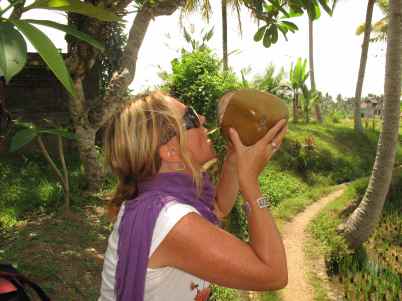
We continue on our way, stopping to crush Citronella leaves which release a strong aroma that repels mosquitoes. We inhale the scent of Melaleuka leaves which are also used as an insect repellant, and pick stalks of lemongrass which are good for colds.Outside a temple Westi points out a tiny little plant not much bigger than my hand, it’s a banyan, one of the most sacred of all trees, it seems hard to imagine that this scrawny little thing will one day be a magnificent sprawling mass of branches and vines.
Westi and Lilir are both keen to revive and preserve the natural heritage of herbalism, for the sake of the young generation of Balinese, and for the tourists who flock to the island. With the help of Melanie Templar from the UK, they established Utama Spice in 1997 which produces a range of high quality herbal beauty products, including lotions, oils and soaps. Westi tells me that some of their clients were interested to know more about the natural substances they used, which gave them the idea of taking guests on guided walks. He says that there goal is sustainable tourism “You must have an income, but it should be a positive income, whereby you also look after the environment and share ancient knowledge.”
I meet Lilir back at their little shop on Sweta street in Ubud, she is tiny in stature, but big in spirit, and bubbles with enthusiasm. She tells me that her family had strong healing traditions and the brood of 11meant that there was no money for doctors, instead all ills were cured by trips to the living drugstore – the family garden.It has been a pleasure to meet this couple who are so passionate and dedicated, and I feel like I have learned more in these few hours than I have in years of living on the island. Lilir invites me to come another time and sample her special tumeric tonic and to join one of her Jamu classes, but that’s another trip, another story.
Book one day in advance.
www.baliherbalwalk.com
info@baliherbalwalk.com
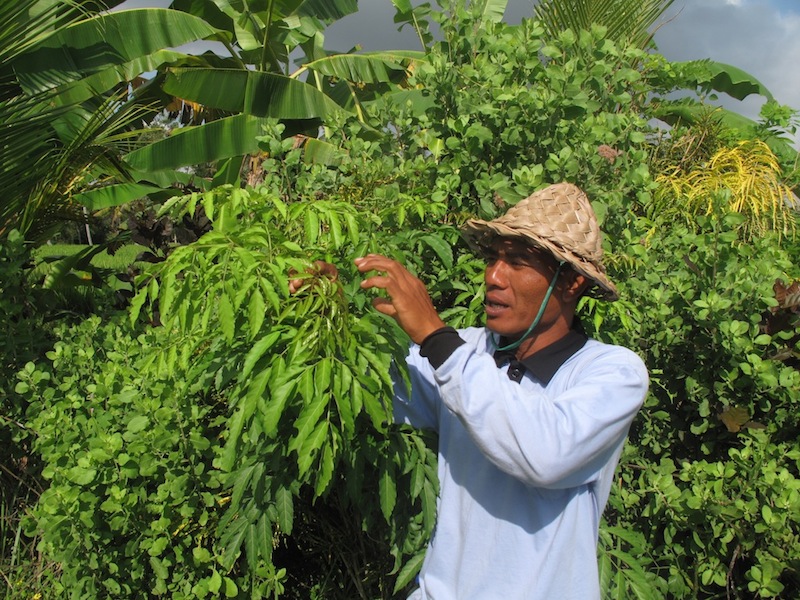
 Climbing up the ravine, we pass a heavily laden soursop tree – its leaves are believed to have a similar effects to chemotherapy when it comes to treating cancer. Winding through a dense coconut grove we see immense jackfruit trees, their large bulbous fruit makes a great addition to curries, soups and [rujak] – Balinese spicy fruit salad. Suddenly the forest opens up to a glistening verdant sea of green that stretches as far as we can see. This is the Bali of postcards, and a view that I never seem to tire of. Palms and big-fronded banana trees line the path that threads across the sawah (rice fields), where dragonflies flitter and the sound of trickling water is ever present. The ancient irrigation system, known as [subak], allows a number of edible plants to thrive spontaneously along the edges, including succulent lentor (snake beans), tiny wild eggplant, and pumpkin – the deep yellow pumpkin flower makes a very tasty tempura. The cassava tree has pretty umbrella-shaped leaves, and its starchy roots are used to make[tape] (tapioca), while its young leaves grace pork soup. Wena shows me a bunie tree, in season it will have delicious dark berries that taste great in jam and also in rujak.
Climbing up the ravine, we pass a heavily laden soursop tree – its leaves are believed to have a similar effects to chemotherapy when it comes to treating cancer. Winding through a dense coconut grove we see immense jackfruit trees, their large bulbous fruit makes a great addition to curries, soups and [rujak] – Balinese spicy fruit salad. Suddenly the forest opens up to a glistening verdant sea of green that stretches as far as we can see. This is the Bali of postcards, and a view that I never seem to tire of. Palms and big-fronded banana trees line the path that threads across the sawah (rice fields), where dragonflies flitter and the sound of trickling water is ever present. The ancient irrigation system, known as [subak], allows a number of edible plants to thrive spontaneously along the edges, including succulent lentor (snake beans), tiny wild eggplant, and pumpkin – the deep yellow pumpkin flower makes a very tasty tempura. The cassava tree has pretty umbrella-shaped leaves, and its starchy roots are used to make[tape] (tapioca), while its young leaves grace pork soup. Wena shows me a bunie tree, in season it will have delicious dark berries that taste great in jam and also in rujak. Finishing in the charming restaurant set amidst the rice fields, we sip fresh coconuts and feast on organic rice, smoked duck and chicken and tofu skewers.
Finishing in the charming restaurant set amidst the rice fields, we sip fresh coconuts and feast on organic rice, smoked duck and chicken and tofu skewers.




